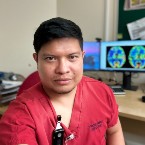May is Stroke Awareness Month—a time when clinicians across the globe unite to raise awareness about stroke’s devastating and unpredictable nature. As a Stroke Nurse Consultant, I’ve seen how it strikes without warning and instantly changes lives.
Over the past 12 years, I’ve cared for stroke patients of all ages—young professionals, new parents, even teenagers. It’s now a cliché to call stroke a disease of the elderly. That perception is outdated. Despite advances, awareness and timely response are still lacking—and that delay can cost lives.
From a remote island to the NHS frontline
I was born and raised on an island in the Philippines—beautiful, but far removed from medical infrastructure. Fifteen years ago, when I left, stroke was often a death sentence. CT scans were scarce and located in cities far from rural communities. Many patients endured long journeys just to get diagnosed—often too late, as the brain damage had already occurred.
Stroke rehabilitation was practically non-existent. Physiotherapy and occupational therapy were expensive and accessible only in urban areas. I had never seen a speech and language therapist perform a swallow assessment before moving to the UK. It wasn’t about neglect—we simply didn’t have the resources. When I joined the NHS, my understanding of stroke care transformed.
Learning the urgency of stroke care
Here, I discovered time-critical treatments like thrombolysis and thrombectomy. I learned how vital it is to act fast—to reverse anticoagulation, rapidly lower blood pressure in haemorrhagic stroke, and expedite brain imaging. Stroke management is truly a race against time.
I was naive at first, but I committed to learning—doubling, even tripling my study. Over time, stroke medicine became my passion. Today, I manage acute stroke patients at the front door and support their recovery through follow-up care. I also represent the RCN Neuroscience Forum in the Intercollegiate Stroke Working Party, helping shape national stroke policy.
The reality of inequity—Even here
Despite the UK’s robust stroke care system, challenges remain. Thrombectomy access is still inconsistent across regions, and CYP2C19 genotyping—potentially key for guiding antiplatelet therapy—isn’t widely available. Every time I see someone miss out on treatment they might have benefitted from, it highlights the need for continued advocacy.
I also think often of my hometown—and similar places around the world—where life-saving interventions are out of reach altogether.
Nurses: educators, advocates, lifesavers
We can’t eliminate global health disparities overnight. But as nurses, we are powerful educators and advocates. Teaching the public how to recognise stroke symptoms and act fast is one of the most impactful things we can do.
The FAST acronym—Face, Arms, Speech, Time—remains one of our strongest tools. Recognising signs and acting quickly reduces disability, saves lives, and gives patients a fighting chance.
I urge my fellow nurses: during Stroke Awareness Month, talk about stroke in your clinics, wards, communities, and online. Because when we share knowledge, we empower action.
Final thoughts
It pains me to say that in the community I grew up in, people often didn’t stand a chance after a stroke. But here in my current role, I see what’s possible when timely care is available. I feel fortunate to work at the frontline of stroke care—and a deep responsibility to improve it further.
Let this month be more than a campaign. Let it be a call to act—educate, advocate, and drive change so that patients everywhere, regardless of where they live, get the care they deserve.


 Share on LinkedIn
Share on LinkedIn




